We’re getting to that time of year… predictions and buzz for the Newbery and Caldecott medals.
We start to see all the Best Of the Year lists. Schools and librarians hold mock Newbery and Caldecott events. Blogs such as Heavy Medal and Calling Caldecott have discussions and begin voting.
In a simpler time, (before I had served on the Caldecott committee) I took all of this very seriously. I followed which books got the most stars. I paid attention to which books tended to win the most mocks. I thought the important books were the ones everyone was talking about.
But now…. I think about buzz very differently. It’s the same reason I’ve stopped making predictions.
The only opinions that count about who will win the Newbery and Caldecott are the people on the Newbery and Caldecott committees that year. I know everyone knows this intellectually but it bears repeating. And even their opinions can change dramatically during the two-day award discussion which takes place right before the medals are handed out.
Let’s break down each kind of buzz.
Best of Year lists: these are usually given by review journals such as The Horn Book, Publisher’s Weekly and School Library Journal. Sometimes regional publications such as The Washington Post or The New York Times make lists too. These can be great lists, but they are not necessarily predictors. The publications pick the best of what they have seen and reviewed, which can be very different depending on what kind of publication they are. They are judging the books (and giving stars) according to their own standards of what makes a good book, not according to the Caldecott or Newbery criteria.
Other awards: just like many people look at the Golden Globes to see what will win the Oscars, early awards are often scrutinized to see what will win the Newbery and Caldecott. But once again, every one of these awards have different criteria, receive different books, have different procedures and different judges. It’s comparing apples to pineapples or kumquats.
Mock winners: I love Mock Caldecotts and Mock Newberys. I have been delighted in recent years to start seeing Mock Geisels, Siberts, Coretta Scott Kings and more. I think they are terrific and lots of fun. There are usually two different kinds- those done with adult library and book professionals, and those done with children. The ones done with adults can generate some wonderful discussions and the ones done with students can be terrific teaching moments. But they both have flaws from being compared with the real committees. One, the selection of books is curated and small and usually books that are already well known are the only ones considered. Two, the time for discussion is short and goes into relatively little depth. Three, a discussion done by first graders just isn’t the same as a discussion done by the award committee. The results of these groups can’t begin to compare with the work and study done by the actual committees.
Personal blogs: These are personal opinions. And no matter how brilliant and amazing the person writing the opinion is, they have not had to study all the books, defend their opinions, discuss it with fourteen other people and come to a compromise.
Award blogs: I love these blogs and read them and vote for their winners. Again, only a curated selection is available. Rightly so…. there is no way anyone would want to read, analyze or vote on the hundreds and hundreds of books the committees receive. But since usually, only the best known books are available to be selected from, those are the ones that win. And voters usually do not read every single book available, but vote for the ones they are the most familiar with.
Discussion groups: I’m a member of an online award prediction group. It amazes me how many participants discuss books that are ineligible, or they refer to things that are not part of the award criteria. They can be as passionate as they like about a book, but if the artist is a resident and citizen of Canada, the book will never win the Newbery or Caldecott.
What happens is that since we typically see the same books over and over, we think that those are the important books. But those are the books that are generally by famous authors, have gotten a lot of publicity, won other awards or gotten a lot of stars. If you look in the pile of books received by an award committee, you will see so many other books: books by first time authors that have gotten little publicity, books by smaller publishers and many more that do not show up in any of the buzz mentioned above.
Take buzz at exact face value. A best of year list is a publication’s favorite books. Another award won is just that… the winner of that other award. A mock Newbery is a group of people having a fun discussion. None of it adds up to real predictions.
If you have a book that’s been getting a lot of buzz this season, maybe I’ve taken the wind out of your sails with this post. But I don’t mean to at all. If your book is showing up again and again and again, it means that a lot of people have noticed it is a quality book. And if they have noticed, the Caldecott and Newbery committees have probably noticed it too.
If you have a book that no one has mentioned this season, this post is for you too. The committees see and consider everything, and that includes your book. The committee may be talking about your book, even if no one else is.
I can’t even imagine how hard it must be for creators and publishers to tune all of this out. Especially, now that social media makes it possible to tag an illustrator on Twitter every time they win a class mock Caldecott. Imagine what it must be like to get dozens or hundreds of tags as the awards get close and then not getting a phone call. I feel for all of you.
Stay strong.
 These special trees were a gift from the government of Japan in 1912. There are currently about 4,000 trees and I am not their only fan. Usually more than a million people visit the blossoms every year. There is the National Cherry Blossom Festival, a parade, a kite festival, and so much more. There is even a cherry blossom cam! It is an enormous celebration.
These special trees were a gift from the government of Japan in 1912. There are currently about 4,000 trees and I am not their only fan. Usually more than a million people visit the blossoms every year. There is the National Cherry Blossom Festival, a parade, a kite festival, and so much more. There is even a cherry blossom cam! It is an enormous celebration.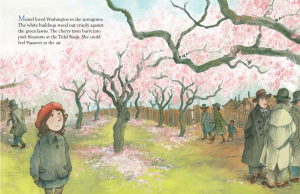
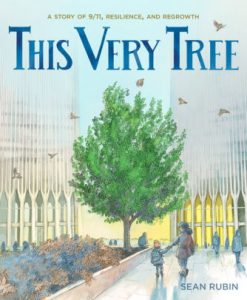 ery Tree: A Story of 9/11, Resilience, and Regrowth. It is written and illustrated by Sean Rubin, the illustrator of The Passover Guest and is being published May 4 from Henry Holt. A truly beautiful book.
ery Tree: A Story of 9/11, Resilience, and Regrowth. It is written and illustrated by Sean Rubin, the illustrator of The Passover Guest and is being published May 4 from Henry Holt. A truly beautiful book. 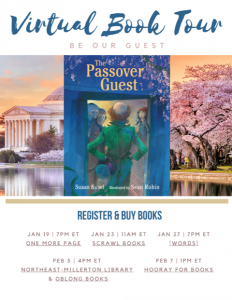
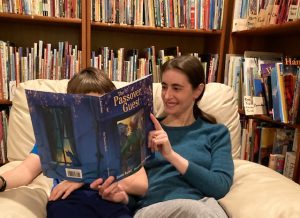
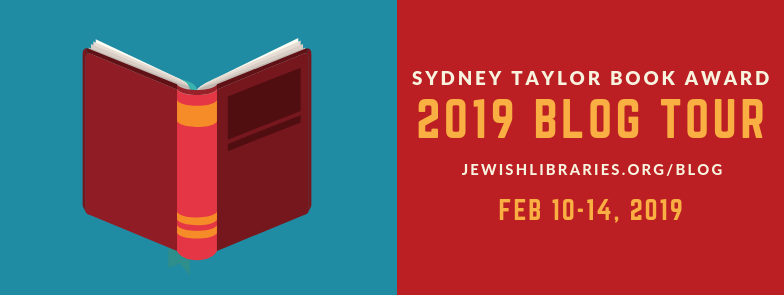
 The Youth Media Awards on Monday have amazing energy, enthusiasm… and props. When the committees are asked to rise and be recognized, a lot of them hold up objects that represent their winners. I was determined that if we were going to be part of the YMAs, we were going to do it right. And that meant finding props. In Seattle. With only an hour of free time to accomplish the mission. My quest began with trying to find a Victorian London chimney sweep broom for
The Youth Media Awards on Monday have amazing energy, enthusiasm… and props. When the committees are asked to rise and be recognized, a lot of them hold up objects that represent their winners. I was determined that if we were going to be part of the YMAs, we were going to do it right. And that meant finding props. In Seattle. With only an hour of free time to accomplish the mission. My quest began with trying to find a Victorian London chimney sweep broom for 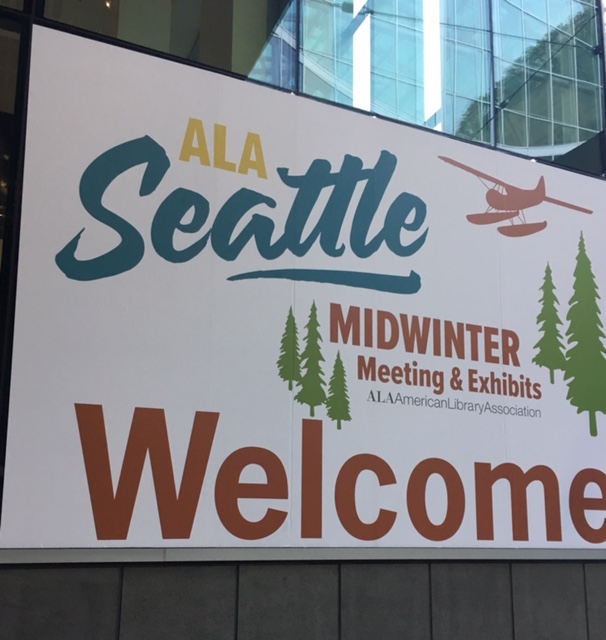 Now that I had everything I needed for Monday morning, I went to the press conference meeting for the award committee chairs on Friday night. It was exciting to be in the room with the chair from every award committee and feel part of the group. I was handed a folder with all the Sydney Taylor information. Late on Friday night, Sylvie Shaffer (one of the Sydney Taylor committee members) and I were both at a publisher party at the Seattle Public Library. Instead of mingling, we sat on the floor of the library; deep in the stacks, proofreading the press release and script for our part of the webcast while the party swirled around us. The weekend went on, the events of ALA took over and suddenly Sunday night arrived. The year of careful prep work seemed to fade away and it felt like there was still so much left to do before the next day. I truly began to panic, but incoming chair Rebecca Levitan had arrived and helped me through it. We needed lists of press contacts. Final press releases. Social media posts. A million and one things. Rebecca and I sat on the floor of our hotel room, and went through one thing at a time, with wonderful people from the
Now that I had everything I needed for Monday morning, I went to the press conference meeting for the award committee chairs on Friday night. It was exciting to be in the room with the chair from every award committee and feel part of the group. I was handed a folder with all the Sydney Taylor information. Late on Friday night, Sylvie Shaffer (one of the Sydney Taylor committee members) and I were both at a publisher party at the Seattle Public Library. Instead of mingling, we sat on the floor of the library; deep in the stacks, proofreading the press release and script for our part of the webcast while the party swirled around us. The weekend went on, the events of ALA took over and suddenly Sunday night arrived. The year of careful prep work seemed to fade away and it felt like there was still so much left to do before the next day. I truly began to panic, but incoming chair Rebecca Levitan had arrived and helped me through it. We needed lists of press contacts. Final press releases. Social media posts. A million and one things. Rebecca and I sat on the floor of our hotel room, and went through one thing at a time, with wonderful people from the 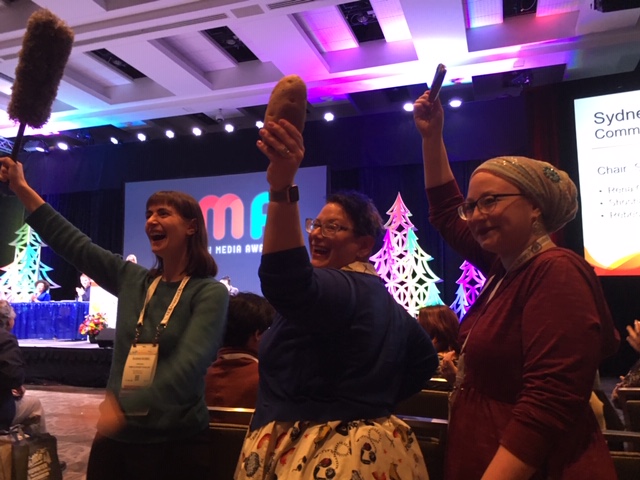 Despite all the work leading up to it, I don’t think anything could have prepared us for the actual moment when the Sydney Taylor awards were announced. We laughed. We cried. It was way better than Cats. It was so emotional, standing in front of over a thousand people, with our broom, potato and butterfly.
Despite all the work leading up to it, I don’t think anything could have prepared us for the actual moment when the Sydney Taylor awards were announced. We laughed. We cried. It was way better than Cats. It was so emotional, standing in front of over a thousand people, with our broom, potato and butterfly. 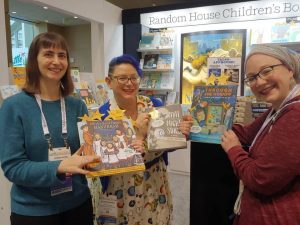 Thank you to all the fantastic
Thank you to all the fantastic